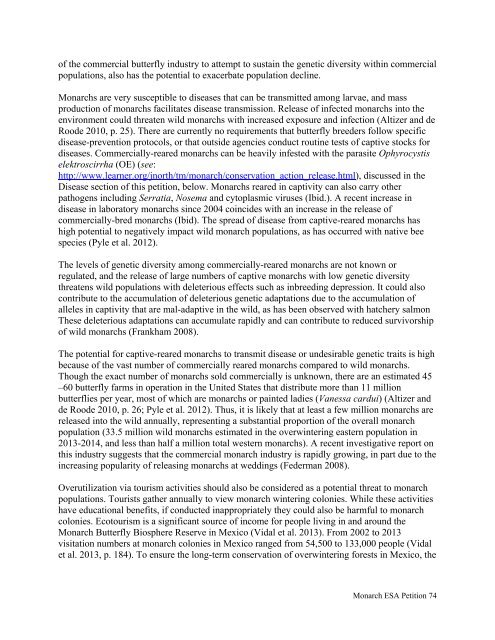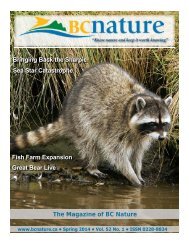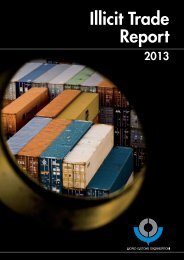monarch-esa-petition-final_61585
monarch-esa-petition-final_61585
monarch-esa-petition-final_61585
Create successful ePaper yourself
Turn your PDF publications into a flip-book with our unique Google optimized e-Paper software.
of the commercial butterfly industry to attempt to sustain the genetic diversity within commercial<br />
populations, also has the potential to exacerbate population decline.<br />
Monarchs are very susceptible to diseases that can be transmitted among larvae, and mass<br />
production of <strong>monarch</strong>s facilitates disease transmission. Release of infected <strong>monarch</strong>s into the<br />
environment could threaten wild <strong>monarch</strong>s with increased exposure and infection (Altizer and de<br />
Roode 2010, p. 25). There are currently no requirements that butterfly breeders follow specific<br />
disease-prevention protocols, or that outside agencies conduct routine tests of captive stocks for<br />
diseases. Commercially-reared <strong>monarch</strong>s can be heavily infested with the parasite Ophyrocystis<br />
elektroscirrha (OE) (see:<br />
http://www.learner.org/jnorth/tm/<strong>monarch</strong>/conservation_action_release.html), discussed in the<br />
Disease section of this <strong>petition</strong>, below. Monarchs reared in captivity can also carry other<br />
pathogens including Serratia, Nosema and cytoplasmic viruses (Ibid.). A recent increase in<br />
disease in laboratory <strong>monarch</strong>s since 2004 coincides with an increase in the release of<br />
commercially-bred <strong>monarch</strong>s (Ibid). The spread of disease from captive-reared <strong>monarch</strong>s has<br />
high potential to negatively impact wild <strong>monarch</strong> populations, as has occurred with native bee<br />
species (Pyle et al. 2012).<br />
The levels of genetic diversity among commercially-reared <strong>monarch</strong>s are not known or<br />
regulated, and the release of large numbers of captive <strong>monarch</strong>s with low genetic diversity<br />
threatens wild populations with deleterious effects such as inbreeding depression. It could also<br />
contribute to the accumulation of deleterious genetic adaptations due to the accumulation of<br />
alleles in captivity that are mal-adaptive in the wild, as has been observed with hatchery salmon<br />
These deleterious adaptations can accumulate rapidly and can contribute to reduced survivorship<br />
of wild <strong>monarch</strong>s (Frankham 2008).<br />
The potential for captive-reared <strong>monarch</strong>s to transmit disease or undesirable genetic traits is high<br />
because of the vast number of commercially reared <strong>monarch</strong>s compared to wild <strong>monarch</strong>s.<br />
Though the exact number of <strong>monarch</strong>s sold commercially is unknown, there are an estimated 45<br />
–60 butterfly farms in operation in the United States that distribute more than 11 million<br />
butterflies per year, most of which are <strong>monarch</strong>s or painted ladies (Vanessa cardui) (Altizer and<br />
de Roode 2010, p. 26; Pyle et al. 2012). Thus, it is likely that at least a few million <strong>monarch</strong>s are<br />
released into the wild annually, representing a substantial proportion of the overall <strong>monarch</strong><br />
population (33.5 million wild <strong>monarch</strong>s estimated in the overwintering eastern population in<br />
2013-2014, and less than half a million total western <strong>monarch</strong>s). A recent investigative report on<br />
this industry suggests that the commercial <strong>monarch</strong> industry is rapidly growing, in part due to the<br />
increasing popularity of releasing <strong>monarch</strong>s at weddings (Federman 2008).<br />
Overutilization via tourism activities should also be considered as a potential threat to <strong>monarch</strong><br />
populations. Tourists gather annually to view <strong>monarch</strong> wintering colonies. While these activities<br />
have educational benefits, if conducted inappropriately they could also be harmful to <strong>monarch</strong><br />
colonies. Ecotourism is a significant source of income for people living in and around the<br />
Monarch Butterfly Biosphere Reserve in Mexico (Vidal et al. 2013). From 2002 to 2013<br />
visitation numbers at <strong>monarch</strong> colonies in Mexico ranged from 54,500 to 133,000 people (Vidal<br />
et al. 2013, p. 184). To ensure the long-term conservation of overwintering forests in Mexico, the<br />
Monarch ESA Petition 74




